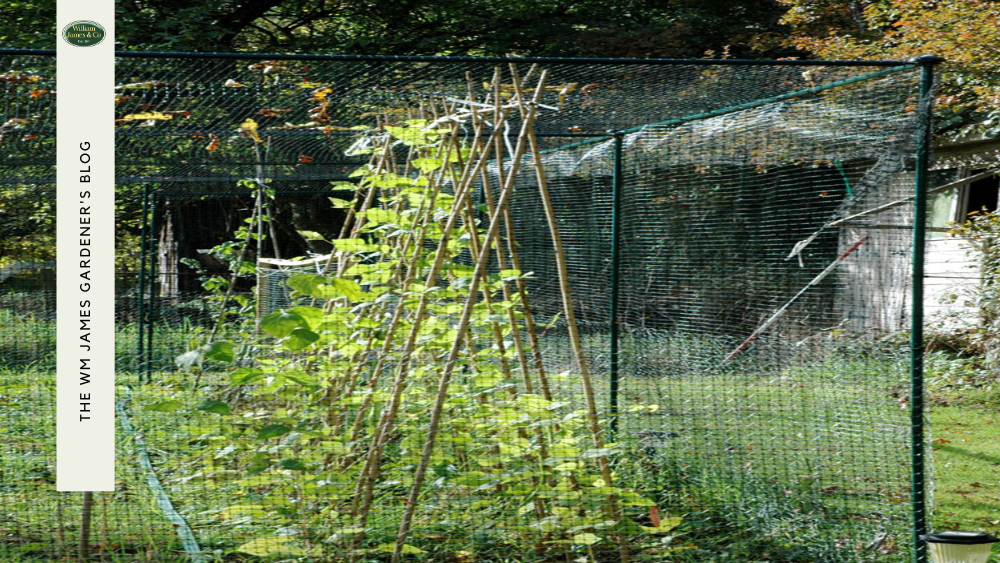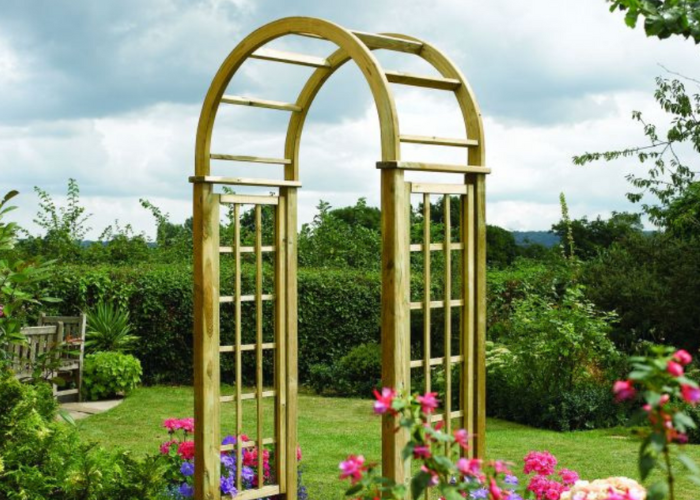We use cookies to make your experience better. To comply with the new e-Privacy directive, we need to ask for your consent to set the cookies. Learn more.
How to Train Climbing Plants: Steps to Follow (With Extra Tips on Pruning)
- Admin
- WM James Gardening Blog
- 5 Mar 2025
-
101views

With our guide on how to train climbing plants, you’ll be well on your way to creating a beautiful and thriving display.
While it might seem tricky at first, training climbing plants is actually a fairly easy (and enjoyable!) process. You don’t have to be Alan Titchmarsh to master it — all you need is a few simple steps and the right tools.
From lovely lilac Wisteria to elegant Clematis, the possibilities are endless when it comes to climbing plants.
No matter whether you’re trying to cover a bare wall, add some greenery to a trellis, or create a stunning centrepiece in your garden, you can follow along with our steps and tips to achieve success.
Before we get into the guide, below are some of our must-have products for your climbing plants project. Shop today with free delivery available*!
Different Types of Climbing Plants You Can Train
If you're in the midst of sprucing up your garden and feel like it's missing some dimension, colour, and visual interest, climbing plants are the perfect way to add it all.
There are many varieties of climbing plants, all boasting different colours and characteristics that can bring your garden to life. Some of the most common in the UK include…
- Clematis
- Honeysuckle
- Wisteria
- Russian vine
- English climbing roses
Despite there being a few different types, they are require more or less the same method of training.
What Tools & Equipment Do You Need to Train Climbing Plants?
If you're starting from scratch and don't have your climbing plant in the ground yet, you'll need some planting, training, and pruning tools.
Luckily for you, here at WM James, we have a wide selection of professional-grade tools that make light work of gardening. They're durable, heavy-duty, and weatherproof — exactly what you want to look for in a quality set of tools.
Check out a selection below, or head to our tools section if you need a bigger upgrade!
Here's our tool kit for planting, training, and pruning your climbing plants:
- A support structure. This could be an arch or arbour with trellis sides or a wall trellis/wire. Hopefully, you already have something you can use, but if not, we have an excellent selection you can browse.
- A fork to aerate and introduce organic matter.
- A spade to dig a hole for your plant.
- Garden ties that won't damage your plant.
- Pocket pruners to help your plant maintain healthy growth.
- Extendable loppers to help remove any dead or diseased areas out of your reach.
- Mulch for planting and the aftercare process.
- Gardening gloves to protect yourself from sharp blades.
How to Train Climbing Plants for Beginners: Starting from Scratch
So, you've got your tools, you've got your support structure, and now it's time to get planting and training your blooms. Without further ado, here is our step-by-step guide:
Step 1) Gather Your Equipment & Select Your Support Structure
If your support structure hasn't been installed yet, you need to tick that off the to-do list before the planting process. Otherwise, you risk disturbing the roots.
Our Balmoral Corner Arbour or Round Top Arch would be the perfect structures if you've not yet found one to your liking. They're extremely robust, weather-resistant, and easy to assemble.
You'll also need the rest of your equipment listed in the tool kit above. Make sure none of your tools are rusty, as this can damage and spread disease to your new plant.
Step 2) Plant the Climber
Now it's time to plant your climber. Have you chosen Wisteria for a whimsical cottage look? Or have you chosen Clematis climbing plants for a beautiful pop of colour?
Either way, we need to get them into the ground, and this is the simplest process for most climbing plants:
First, you need to dig your hole with a stainless steel spade that can get through tough soil. Soil around structures, walls, and fences isn't always the best quality, so you might need to put your back into it.
Top Tip: If your soil is of low quality, mix in some organic matter, like compost, with a garden fork before planting your climbers.
To avoid root competition, you need to dig your hole at least 30-60 cm away from your structure.
Once your hole is dug, you need to remove your climber from its original pot, carefully loosening some roots away from the root ball if it seems a little compact.
Place the rootball into the hole. Most plants like the top of the rootball to be at soil level, but depending on your climber, you'd need to check.
Cover the rootball with the soil you dug out, water well, and mulch around the base of the plant to deter weeds and hold moisture.
Step 3) Start Training
Most climbing plants come with support canes already attached, making it even easier for you to get your initial training underway.
Keep the canes where they are, and simply lean them towards the structure.
If your plant is a little more developed already, you can try tying some stems to it using a soft garden tie, preferably one that stretches and grows with your plant, like ours.
Don't tie them too tight, though, or you risk damaging your plant and stunting its growth.
If long enough, try weaving the stems in and out of the trellis to give them a firm grip on the structure. Just be sure to space them out for good air circulation and even coverage.
Shop Our Versatile Garden Ties
Step 4) Monitor & Adjust
If you want your climbing plant's growth to be successful, you need to keep a good eye on it. Check whether it's climbing the trellis, looks damaged, or needs its ties tightened or loosened.
You also need to water it very well. Often, when plants grow close to a structure, rainwater won't fully reach them, so you'll need to do it manually.
You don't have to watch it like a hawk or anything, but a once-a-week check-over wouldn't hurt.
From then on, just shape it to your preferences! There's no doubt you'll be pleased with your efforts.
How to Care for Your Climbing Plants: Aftercare
Now that you've got your plant on the right path to climb, you can't just leave it there. This is where your aftercare comes in.
Don't let your training efforts become a waste of your gardening time, and do these simple steps:
- Check your plant for loose ties, and tighten or replace them where necessary to keep it on the right track.
- To encourage continuous healthy growth, remove any dead, diseased, or damaged stems with pocket pruners — using gardening gloves, of course!
- Check for signs of pests, like aphids. If you'd like to learn more, we've put together a guide on how to remove these irritating insects.
- During the winter months, mulch around the base of the plant to protect the roots from frost. For less hardy plants, you could also cover them with fleecing or bubble wrap.
- Regularly water and prune your plants to maintain healthy growth.
Shop Our Garden Fleecing Today!
Pruning Tips
Pruning climbers is a necessary and satisfying job that can make the difference between a disappointing display of blooms and a wondrous arrangement.
You already know that you need to prune away the dead, diseased, and damaged parts of your plant the minute you see them, but what other pruning tips do you need to know?
- As a general rule, plants that flower in the winter, spring, or early summer need to be pruned straight after flowering. Plants that flower through summer or early autumn need to be pruned in late winter or early spring.
- Prune overgrown sections of your plant with extendable loppers if they're high up or smaller snips if they're lower down. This will improve healthy airflow.
- Cut any extremely long shoots that cause your plant to be misshapen. Use pocket pruners to do this.
- Dispose of any diseased or pest-ridden plant matter properly; don't go putting it in your compost heap!
- Avoid cutting too much in one session. You might get a little carried away and end up with half a plant, which probably isn't the outcome you'd like.
Of course, these are just general pruning tips to be aware of. There might be specific requirements for different climbing plants, so if you find your efforts aren't producing the best outcome, it would be best to find out those requirements.
Conclusion: Training Climbing Plants for a Picturesque Garden
You should now have all the information you need to turn your garden into a paradise of verticle colourful climbing plants.
Training climbing plants means adding height to your garden, which transforms outdoor spaces, especially flat and small ones, into lush landscapes.
Not to mention, they can add privacy and shade, too. Who wouldn't want to sit under blooming roses for an afternoon of relaxing?
As we've learnt, climbing plants are also low maintenance, so they're perfect if you don't want to take on a needy plant but still want your garden to be rich with diverse plants and flowers.
Training climbing plants has no downsides, so put on your gardening gloves today and let's get training!
If you have any questions or need further advice on training climbing plants, please feel free to contact us. With 60 years in the horticultural industry, we are more than happy to help!
*Free delivery is available on all orders over £100.
FAQs
Why Do You Need to Train Climbing Plants?
Among many other reasons, training climbing plants is important for controlling their growth, enhancing their aesthetic appeal, and keeping them healthy.
If you leave the climbers to their own devices, they may grow out of control and become tangled, making them difficult to maintain.
What Tools Do You Need for Training Climbing Plants?
You need your support structure in place, such as a trellis, gardening ties, pruning tools, such as pocket pruners, mulch, and gardening gloves.
Check out our post above for a full list of the tools and equipment you'll need to start your project.
How Do You Encourage Plants to Climb?
To encourage your plants to climb, you need some kind of support. The most popular form of support is something with trellis sides, like an arch, arbour, or wall decoration.
Once the plant starts to grow, you should then provide extra support by tying larger branches to the support itself. This will stop the plant from getting weighed down and encourage growth.
What Do You Use to Tie Climbing Plants?
We recommend our super soft and stretchy 40-inch flexible plant ties, which will grow with your plants and secure them when training them to climb.
They're highly durable, allowing you to use them all year round, and reusable for multiple plant uses.
Do Climbing Plants Come Back Every Year?
Some climbing plant varieties, such as perennials like wisteria, will come back and bloom year after year. However, some varieties, such as annuals like sweet peas, will die after their growing season, and you'll need to replant.
Another variety of climbing plants is the evergreen plants. These climbing plants, such as ivy, will maintain their leaves, providing greenery all year round, even during winter.
When Should You Prune Climbing Roses?
You should aim to prune climbing roses between late autumn and early spring when the plant is dormant before the growing season. This will make it easy to see what stems need to be removed and which ones are healthy.

















